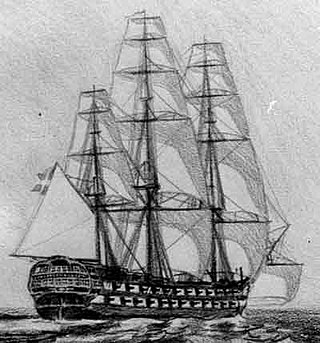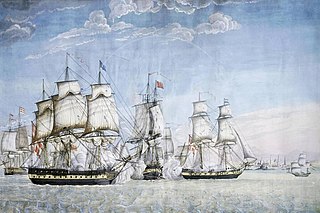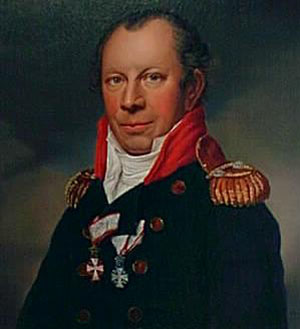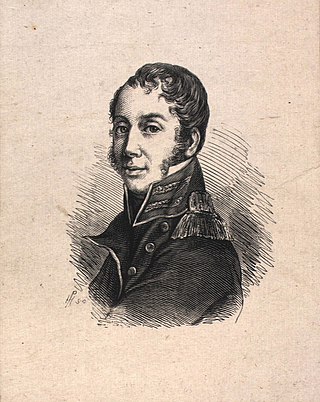
The Gunboat War was a naval conflict between Denmark–Norway and the British during the Napoleonic Wars. The war's name is derived from the Danish tactic of employing small gunboats against the materially superior Royal Navy. In Scandinavia it is seen as the later stage of the English Wars, whose commencement is accounted as the First Battle of Copenhagen in 1801.

Holsteen was a 60-gun ship of the line in the Royal Dano-Norwegian Navy. She was commissioned in 1775 and the British Royal Navy captured her in the Battle at Copenhagen Roads on 2 April 1801. The British renamed the ship HMS Holstein, and later HMS Nassau. She participated in one major battle during the Gunboat War and was sold in 1814.

The action of 16 May 1797 was a naval battle that took place near Tripoli in Ottoman Tripolitania. The Danish squadron was victorious over a Tripolitan squadron that outnumbered them in terms of the number of vessels. The result was a peace treaty between the Bey of Tripoli and Denmark-Norway.

HDMS Najaden was a frigate of the Royal Dano-Norwegian Navy, which she served from 1796 until the British captured her in 1807. While in Dano-Norwegian service she participated in an action at Tripoli, North Africa. She served the Royal Navy as the fifth rate HMS Nyaden from 1808 until 1812 when she was broken up. During her brief British service she participated in some small attacks in the Barents Sea during the Anglo-Russian War.
HMS Dictator was a 64-gun third-rate ship of the line of the Royal Navy, launched on 6 January 1783 at Limehouse. She was converted into a troopship in 1798, and broken up in 1817.
HMS Circe was a Royal Navy 32-gun fifth-rate frigate, built by Master Shipwright Joseph Tucker at Plymouth Dockyard, and launched in 1804. She served in the Caribbean during the Napoleonic Wars, and participated in an action and a campaign for which in 1847 in the Admiralty authorised the issuance of the Naval General Service Medal with clasps. The action, off the Pearl Rock, near Saint-Pierre, Martinique, was a debacle that cost Circe dearly. However, she also had some success in capturing privateers and a French brig. She was sold in 1814.

HMS Belette was an 18-gun Cruizer-class brig-sloop, built by King at Dover and launched on 21 March 1806. During the Napoleonic Wars she served with some success in the Baltic and the Caribbean. Belette was lost in the Kattegat in 1812 when she hit a rock off Læsø.
During the period of the Napoleonic Wars, two vessels have served the British Royal Navy as His Majesty's Hired armed cutter Idas, named for Idas, a figure from Greek mythology.

HMS Seagull was the name vessel for the Seagull class of brig-sloops of the Royal Navy. She was launched on 1 July 1805 and saw active service under the British flag in Danish waters until 19 June 1808 when Dano-Norwegian forces sank her. The Danes raised her and refitted her for service in the Dano-Norwegian Navy, which she served until the end of the English Wars in 1814. She then was transferred to the Norwegians. She was finally decommissioned in 1817.

Carl Wilhelm Jessen was a Danish naval officer and Governor of St Thomas in the Danish West Indies.
HMS Comus was a 22-gun Laurel-class sixth-rate post ship of the Royal Navy. She was launched in 1806. In 1807 she took part in one notable single-ship action and was at the capture of Copenhagen. In 1815 she spent six months with the West Africa Squadron suppressing the slave trade during which time she captured ten slavers and freed 500-1,000 slaves. She was wrecked in 1816 with no loss of life.

The French brig Voltigeur was a Palinure-class brig launched in 1804. The British captured her in 1806 and renamed her HMS Pelican. She was sold in 1812.

Hans Peter Holm was a Danish naval officer who commanded vessels of the Dano-Norwegian Navy in several actions. He commanded several naval vessels during the Gunboat War. His most important action occurred in 1812 at the Battle of Lyngør when a British squadron, led by the British ship-of-the-line HMS Dictator, destroyed his vessel, HDMS Najaden. Holm sustained wounds in the battle but survived, only to drown in an accident shortly afterwards.
The name of Steen Andersen Bille is closely associated with one extended family of Danish naval officers over several generations.

Steen Andersen Bille (1751–1833) was a Danish naval officer and a member of the Bille family. He rose to the rank of admiral and became a Privy Counselor during the period of Denmark's policy of "armed neutrality" following the Gunboat War. He was instrumental in the rebuilding of the Danish Navy after 1814.

HDMS Allart, a brig launched at Copenhagen in June 1807, was amongst the ships taken by the British after the second Battle of Copenhagen. In British service, she was recaptured by Danish-Norwegian gunboats after venturing too close inshore. Her subsequent service was in the Dano-Norwegian Navy's Norwegian Brig Division, which harried enemy frigates and convoys in Norwegian waters. On the separation of Denmark from Norway in 1814, Allart transferred to the Norwegian navy, who sold her in 1825.

HMS Pandora was launched in 1806. She captured two privateers before she was wrecked in February 1811 off the coast of Jutland.
HMS Cherokee was the lead ship of her class of 10-gun brig-sloops of the British Royal Navy. She saw service during the Napoleonic Wars. In 1810 she participated in an engagement that resulted in her crew qualifying for the Naval General Service Medal. The Navy sold Cherokee in 1828. She then became a merchantman trading between Liverpool and Africa. Cherokee was wrecked in August 1831 returning to England from Africa.
HMS Thunder was an 8-gun bomb vessel of the Royal Navy, previously the mercantile Dasher. Dasher, launched at Bideford in 1800, had made two voyages as a slave ship in the triangular trade in enslaved people before the Royal Navy purchased her in 1803 and renamed her HMS Thunder. Thunder served in the Mediterranean and the Baltic; among other actions, she participated in a battle and one single-ship action, each of which resulted in her crew later qualifying for clasps to the Naval General Service Medal (1847). The Navy sold her in 1814.
HDMS Nidelven was a brig launched at Copenhagen on 1 December 1792. She was present at both British attacks on Copenhagen, and the British Royal Navy seized her at Copenhagen on 7 September 1807 at the surrender of Copenhagen. The British took her into service as HMS Nid Elven. She served between 1808 and 1809, during which time she captured a small French privateer. She was laid up in 1809. The Navy sold her in 1814.











